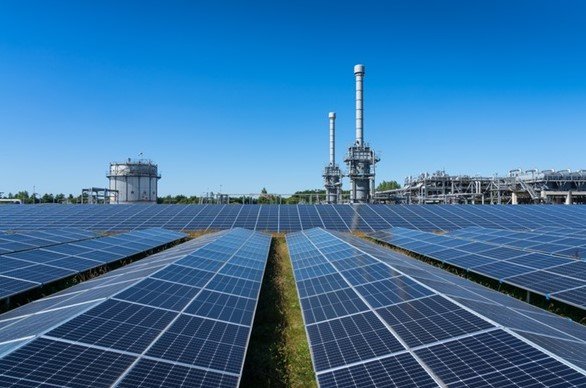Saudi Arabia is racing to switch from oil to renewables, aiming to power its future with the sun and wind, but experts are divided over how much progress the kingdom has really made. While recent growth in renewable energy signals major advancements, challenges remain in meeting its most ambitious goals by 2030.
Power Demand Soaring Beyond Expectations
Driven by rapid industrial expansion, population growth, and a boom in data centers across the region, Saudi Arabia’s electricity demand has surged dramatically. In the first half of 2025 alone, energy consumption rose by 10 percent, crossing a peak demand of more than 75 gigawatts — a historic high for the country.
This rise comes despite efforts to curb usage through increased electricity and water tariffs introduced over several years. Price hikes in 2016, 2018 and 2020, and most recently in May 2025, were designed to reduce overconsumption. Even with those changes, the sheer demand for air conditioning and water desalination continues to strain the grid.
The Costly Habit of Burning Oil for Power
Saudi Arabia still burns a significant amount of crude and fuel oil to generate electricity — a practice most countries globally have phased out due to high cost and environmental impact. On average, the kingdom uses about 1.1 million barrels per day (bpd) for power and water production. During peak summer months, this can rise to more than 1.4 million bpd.
This practice eats into oil exports and creates complications for Saudi Arabia’s commitments under OPEC production limits. Every barrel used domestically is one less available to export on the global market, essentially leaving revenue on the table.

The 2030 Goal: Ambitious or Unrealistic?
By 2030, Riyadh’s target is clear and bold: stop burning oil for electricity. The roadmap includes building 130 gigawatts of renewable capacity, with renewables generating more than 50 percent of the kingdom’s electricity. The balance is expected to come from natural gas.
Here’s a breakdown of Saudi Arabia’s goals and progress:
| Vision 2030 Target | Status as of August 2025 |
|---|---|
| End oil use for power | Still consuming 1.1 to 1.4 million bpd |
| 130 GW renewable power | 10.2 GW currently operational |
| Renewables at 50% share | Below 15 percent |
Although far from the finish line, Saudi Arabia is no longer at the starting block. After multiple false starts since the King Abdullah City for Atomic and Renewable Energy’s 2013 goals of 58.7 GW, the pace has now accelerated.
Recent Progress Suggests Change Is Possible
Saudi Arabia has added more than 5 GW of renewable capacity in the past two years. Most of this comes from large-scale solar photovoltaic (PV) farms developed through public-private partnerships with global clean energy firms.
Ongoing and upcoming projects include:
- Sudair Solar Plant (1.5 GW) nearing final commissioning
- Dumat Al Jandal Wind Farm (400 MW) already in operation
- Plans to develop several solar plants in Makkah and Madinah regions
- Tender rounds targeting another 20 GW by late 2026
The Public Investment Fund (PIF) is also taking a lead role, financing green hydrogen projects and investing in the NEOM city’s 100% renewable power targets. These steps show a shift from announcement to action.
The Challenges That Could Stall The Vision
While investment and intent are clear, several real-world barriers remain:
- Grid Infrastructure: Much of the kingdom’s power transmission system still needs upgrades to handle renewable integration, especially away from oil-rich areas.
- Storage Technology: Without large-scale battery storage or demand management, solar and wind alone can’t provide stable baseload power.
- Regulatory Hurdles: Some developers still express concern about bureaucratic delays and guaranteed purchase agreements.
- Skilled Workforce: Lack of local expertise in clean energy installation and O&M slows project rollout timing.
Global Oil Market Impact: Reality vs Hype
If Saudi Arabia does meet its 2030 goal, that would free up over 1 million barrels per day for export — a significant amount for the global market. In theory, this could reshape energy geopolitics and give Riyadh more flexibility in OPEC decision-making.
However, oil markets may adjust accordingly. The freed-up supply could be offset by rising global demand or reduced output from other players. Currently, the market impact of Saudi Arabia’s domestic energy shift remains more symbolic than tangible.
Is the Kingdom Falling Short or Quietly Rebuilding?
Critics argue that Saudi Arabia is behind schedule and its projects are overhyped. Yet others say the kingdom is finally laying the foundations for a serious energy transformation. The reality may lie somewhere in between.
The shift from oil-rich policies to embracing solar and wind at this scale was never going to be fast or easy. But with visible momentum in the past two years, the kingdom may yet surprise skeptics as 2030 approaches.
As the world watches, Saudi Arabia’s energy transformation continues to unfold shake by shake, watt by watt. Will it lead to a cleaner tomorrow or remain a story of missed targets? Only time will tell.
Share your thoughts in the comments below. What do you think about Saudi Arabia’s clean energy progress? Know someone interested in energy or geopolitics? Share this article with them.
